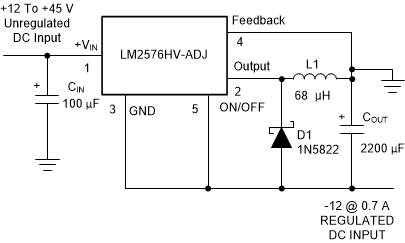JAJS782G june 1999 – march 2023 LM2576 , LM2576HV
PRODUCTION DATA
- 1 特長
- 2 アプリケーション
- 3 概要
- 4 Revision History
- 5 Pin Configuration and Functions
-
6 Specifications
- 6.1 Absolute Maximum Ratings
- 6.2 ESD Ratings
- 6.3 Recommended Operating Conditions
- 6.4 Thermal Information
- 6.5 Electrical Characteristics: 3.3 V
- 6.6 Electrical Characteristics: 5 V
- 6.7 Electrical Characteristics: 12 V
- 6.8 Electrical Characteristics: 15 V
- 6.9 Electrical Characteristics: Adjustable Output Voltage
- 6.10 Electrical Characteristics: All Output Voltage Versions
- 6.11 Typical Characteristics
- 7 Detailed Description
- 8 Application and Implementation
- 9 Device and Documentation Support
- 10Mechanical, Packaging, and Orderable Information
パッケージ・オプション
デバイスごとのパッケージ図は、PDF版データシートをご参照ください。
メカニカル・データ(パッケージ|ピン)
- NDH|5
- NEB|5
- KTT|5
- KC|5
サーマルパッド・メカニカル・データ
- KTT|5
発注情報
8.1.9 Inverting Regulator
Figure 8-1 shows a LM2576-12 in a buck-boost configuration to generate a negative 12-V output from a positive input voltage. This circuit bootstraps the ground pin of the regulator to the negative output voltage, then by grounding the feedback pin, the regulator senses the inverted output voltage and regulates it to −12 V.
For an input voltage of 12 V or more, the maximum available output current in this configuration is approximately 700 mA. At lighter loads, the minimum input voltage required drops to approximately 4.7 V.
The switch currents in this buck-boost configuration are higher than in the standard buck-mode design, thus lowering the available output current. Also, the start-up input current of the buck-boost converter is higher than the standard buck-mode regulator, and this can overload an input power source with a current limit less than
5 A. Using a delayed turn-on or an undervoltage lockout circuit (described in Section 8.1.10) can allow the input voltage to rise to a high enough level before the switcher can be allowed to turn on.
Because of the structural differences between the buck and the buck-boost regulator topologies, the buck regulator design procedure section can not be used to select the inductor or the output capacitor. The recommended range of inductor values for the buck-boost design is between 68 μH and 220 μH, and the output capacitor values must be larger than what is normally required for buck designs. Low input voltages or high output currents require a large value output capacitor (in the thousands of micro Farads).
The peak inductor current, which is the same as the peak switch current, can be calculated in Equation 6:
where fosc = 52 kHz
Under normal continuous inductor current operating conditions, the minimum VIN represents the worst case. Select an inductor that is rated for the peak current anticipated.
 Figure 8-1 Inverting Buck-Boost Develops −12 V
Figure 8-1 Inverting Buck-Boost Develops −12 VAlso, the maximum voltage appearing across the regulator is the absolute sum of the input and output voltage. For a −12-V output, the maximum input voltage for the LM2576 is +28 V, or +48 V for the LM2576HV.